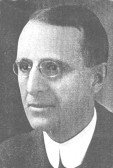Member Biography
Johnson Lindsay Rowlett Parsons
(1876.01.18 - 1935.03.10)
SPS, OLS, DLS, SLS
Commission #019
(1910.06.10)
Johnston Parsons, surveyor, engineer and soldier was appointed the first President of the Saskatchewan Land Surveyors Association upon it's inauguration in 1910. He continued in that capacity in 1911.
Mr. Parsons settled in Regina in 1904 and was with his brother Wellington Parsons in the firm "Parsons Construction and Engineering Company Limited". Their letterhead stated: "Contractors for all kinds of concrete construction, bridges, foundations, subways, buildings and pavement".
They were housed in the Mickleborough Block at 1712 Scarth Street. Naming a few of their larger construction projects:
Broad Street Bridge
Broad Street and Albert Street Subways
Royal Bank Building of Canada
Connaught School
Leader Post Building
Regina Jail
McCallum Building
Mr. Parsons, born in 1876, attended Harbord Collegiate in Toronto and graduated with a Bachelor of Arts (with honors) from Toronto University in 1897. Not satisfied, he continued his education and graduated from the School of Practical Science in 1900. During the summer months he was engaged on geological surveys in northern Ontario and after graduation he was employed by the Algoma Commercial Company at Sault Ste Marie, Ontario, until 1903 as a Geologist. During this time he acquired his Dominion Land Surveyors Commission and his commission as an Ontario Land Surveyor in 1905.
During the years, 1903 to 1908, he worked on Dominion Land Surveys covering a multitude of township outlines and complete township subdivisions on the prairies. One of his reports to the Surveyor General in 1905, covered Townships 5 to 8 in Ranges 19 to 21 west of the 2nd meridian in the then North West Territory - the area is West of Weyburn, Saskatchewan. The report reads in part:
"The Townships were reached by me from Goose Lake trail (Old Bone trail) by travelling south along east outlines of townships 5 and 4 range 18. Township 3 is crossed diagonally by the police trail running from Weyburn to the N.W.M.P. station at Wildman Butte on the international boundary and in good condition. The soil is rather light for farming. No timber occurs. Crystal, Alma and Wellington lakes are alkaline. No streams occur. No water-powers occur. No fuel occurs. Coal and wood for camp purposes were obtained at Yellowgrass. Only game is antelope, ducks and geese. Fresh water in hay marshes and sloughs."
The area today appears to be basically big farms.
During this time he surveyed 1994 miles at a cost to the Federal Government of $7.73 per mile, The following year he covered 1,937 miles which amounted to a cost of $7.83 per mile ( we assume the cost of living went up by 10 cents per mile). The 1,937 miles included 1,646 miles of subdivision, 129 miles of outline surveys and 162 miles of traverse.
Surety bonds were also required by the surveyor and it took the form of a bond between "The United States Fidelity and Guaranty Company of Baltimore and leis Majesty King Edward, represented by the Minister of Interior of Canada'". The bond covered default of the contractor (Parsons) for $5,000 and the survey to be completed by 31 December 1905. The contract with the Surveyor General included in part:
Section lines at $3.50 per mile
Township outlines at a maximum of $2.00 per mile
One dollar paid for every statutory declaration of a settler
An allowance paid for determination bearings
A maximum error of six minutes
I surmise that the other costs to the government were made up by material, camp, labor and other costs associated with the field and office personnel. In one of Mr. Parsons letters to the Deputy Minister of Interior he writes:
I may say further, that I have been obliged, in order to perform the survey economically to buy nine horses and six vehicles and this with the addition of a large camp outfit and instruments brings my expenditures up to nearly $2,500. Due to prairie fires I have to bring in team oats at 50 cents per bushel, a distance of 25 miles - we use 100 pounds per day.
Since he finished the field work in early August 1905 he applied and received more contracts for township surveys. However, when he asked for more work on November 11, 1905, the reply from Surveyor General E. Deville read:
"No further addition to contract can be made."
I wonder if they didn't have any more work or ran over budget (at $7 per mile) or would not believe Mr. Parsons could be that fast in running subdivision surveys on the prairie. He did receive further contracts in 1906 and again in 1908.
While attending Toronto University he became interested in the military and as a result joined the Queen's own Rifles in 1898. Later he progressed to Captain in the Princess Patricia Canadian Light Infantry. His record of service with the Canadian Expeditionary Force in the First World War was most outstanding. Embarked for England in April 1915 as a Major and went to France the same year. In 1916 he was appointed to Lieutenant Colonel.
After the war (1919) he was again active in his engineering company and other interests until his retirement in 1925.
Prior to the war (1910) he married Minnie Weldon from Shediac, New Brunswick. They were blessed with two children, Alma Kathleen {married D.E.J. Bostwick of St. John, N.B. in 1936) and a son Hailburton Parsons.
When Mr. Parsons retired from his business in Regina he moved to the East coast. Then in 1931 he was appointed temporary Brigadier, as District Officer Commanding Military District Number 7. Due to ill health he retired, in 1935, to pension, medically unfit and granted Honorary rank of Brigadier. He died 10 March 1935 at Saint John, New Brunswick.
His honours and awards included the Distinguished Service Order, French Croix de Guerre, mentioned in dispatches several times and many other military appointments.
The first executive council of our association consisted of;
President J.L.R. Parsons
Vice-Pres. W. Reilly
Council - Garner and Moberly
Sec. Treas. - M.B. Weekes
At that time the association had 19 members at a fee of $5 per year.
Compiled by John H.Webb. S.L.S.(L.M.); C.L.S. November, 1995.


